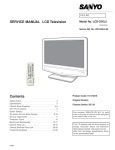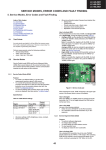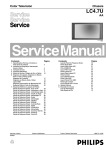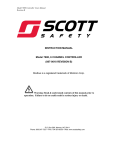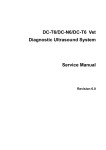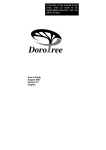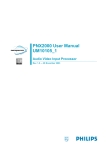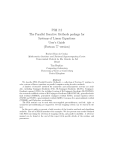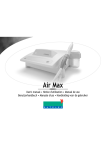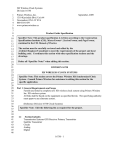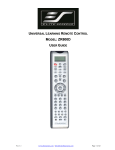Download bl2.xu_aa - Turuta Electronics World
Transcript
Service Modes, Error Codes, and Fault Finding BL2.1U, 2.2U, 2.3U 5. EN 19 5. Service Modes, Error Codes, and Fault Finding Index of this chapter: 5.1 Test Points 5.2 Service Modes 5.3 Stepwise Start-up 5.4 Service Tools 5.5 Error Codes 5.6 The Blinking LED Procedure 5.7 Protections 5.8 Fault Finding and Repair Tips 5.9 Software Upgrading 5.1 • • • Test Points The chassis is equipped with test points (Fxxx) printed on the circuit board assemblies. As most signals are digital, it will be almost impossible to measure waveforms with a standard oscilloscope. Therefore, waveforms are not given in this manual. Several key ICs are capable of generating test patterns, which can be controlled via ComPair. In this way it is possible to determine which part is defective. How to Activate SDM Use one of the following methods: • Use the standard RC-transmitter and key in the code “062596”, directly followed by the “MENU” button. Note: It is possible that, together with the SDM, the main menu will appear. To switch it "off", push the “MENU” button again. • Short for a moment the two solder pads [1] on the SSB, with the indication “SDM”. They are located outside the shielding. Activation can be performed in all modes, except when the set has a problem with the Stand-by Processor. See figure “SDM service pads”. Perform measurements under the following conditions: • Service Default Mode. • Video: Color bar signal. • Audio: 3 kHz left, 1 kHz right. 5.2 frequency to which the set will tune, would be as specified in the channel map and could be different from the one corresponding to the physical channel 3. All picture settings at 50% (brightness, color, contrast). All sound settings at 50%, except volume at 25%. All service-unfriendly modes (if present) are disabled, like: – (Sleep) timer. – Child/parental lock. – Picture mute (blue mute or black mute). – Automatic volume levelling (AVL). – Auto switch "off" (when no video signal was received for 10 minutes). – Skip/blank of non-favorite pre-sets. – Smart modes. – Auto store of personal presets. – Auto user menu time-out. Service Modes Service Default Mode (SDM) and Service Alignment Mode (SAM) offer several features for the service technician, while the Customer Service Mode (CSM) is used for communication between a Customer Helpdesk and a customer. 1 There is also the option of using ComPair, a hardware interface between a computer (see requirements below) and the TV chassis. It offers the ability of structured troubleshooting, test pattern generation, error code reading, software version readout, and software upgrading. Minimum requirements for ComPair: a Pentium processor, Windows 95/98, and a CD-ROM drive (see also paragraph “ComPair”). 5.2.1 F_15400_103.eps 110505 Service Default Mode (SDM) Purpose • To create a pre-defined setting, to get the same measurement results as given in this manual. • To override SW protections (only applicable for protections detected by stand-by processor) and make the TV start up to the step just before protection (a sort of automatic stepwise start up). See paragraph “Stepwise Start Up”. • To start the blinking LED procedure (not valid in protection mode). Figure 5-1 SDM service pads After activating this mode, “SDM” will appear in the upper right corner of the screen (if you have picture). How to Navigate When you press the “MENU” button on the RC transmitter, the set will toggle between the SDM and the normal user menu (with the SDM mode still active in the background). Specifications How to Exit SDM Use one of the following methods: • Switch the set to STAND-BY via the RC-transmitter. • Via a standard customer RC-transmitter: key in “00”sequence. Table 5-1 SDM default settings Region Freq. (MHz) Default system Europe, AP-PAL/Multi 475.25 PAL B/G NAFTA, AP-NTSC, LATAM 61.25 (ch. 3) NTSC M • Tuning frequency 61.25 MHz for NTSC: The TV shall tune to physical channel 3 only if channel 3 is an analog channel or if there is no channel 3 installed in the channel map. If there is a digital channel installed in channel 3, then the 5.2.2 Service Alignment Mode (SAM) Purpose • To perform (software) alignments. • To change option settings. • To easily identify the used software version. • To view operation hours. EN 20 • 5. BL2.1U, 2.2U, 2.3U Service Modes, Error Codes, and Fault Finding To display (or clear) the error code buffer. How to Activate SAM Via a standard RC transmitter: key in the code “062596” directly followed by the “INFO” button. After activating SAM with this method a service warning will appear on the screen, you can continue by pressing the red button on the RC. Contents of SAM: • Hardware Info. – A. VIPER SW Version. Displays the software version of the VIPER software (main software) (example: BX23U-1.2.3.4_12345 = AAAAB_X.Y.W.Z_NNNNN). • AAAA= the chassis name. • B= the region: A= AP, E= EU, L= Latam, U = US. • X.Y.W.Z= the software version, where X is the main version number (different numbers are not compatible with one another) and Y is the sub version number (a higher number is always compatible with a lower number). The last two digits are used for development reasons only, so they will always be zero in official releases. • NNNNN= last five digits of 12nc code of the software. – B. SBY PROC Version. Displays the software version of the stand-by processor. – C. Production Code. Displays the production code of the TV, this is the serial number as printed on the back of the TV set. Note that if an NVM is replaced or is initialized after corruption, this production code has to be re-written to NVM. ComPair will foresee in a possibility to do this. • Operation Hours. Displays the accumulated total of operation hours (not the stand-by hours). Every time the TV is switched "on/off", 0.5 hours is added to this number. • Errors. (Followed by maximal 10 errors). The most recent error is displayed at the upper left (for an error explanation see paragraph “Error Codes”). • Defective Module. Here the module that generates the error is displayed. If there are multiple errors in the buffer, which are not all generated by a single module, there is probably another defect. It will then display the message “UNKNOWN” here. • Reset Error Buffer. When you press “cursor right” and then the “OK” button, the error buffer is reset. • Alignments. This will activate the “ALIGNMENTS” submenu. • Dealer Options. Extra features for the dealers. • Options. Extra features for Service. • Initialize NVM. When an NVM was corrupted (or replaced) in the former EMG based chassis, the microprocessor replaces the content with default data (to assure that the set can operate). However, all preferences and alignment values are gone now, and option numbers are not correct. Therefore, this was a very drastic way. In this chassis, the procedure is implemented in another way: The moment the processor recognizes a corrupted NVM, the “initialize NVM” line will be highlighted. Now, you can do two things (dependent of the service instructions at that moment): – Save the content of the NVM via ComPair for development analysis, before initializing. This will give the Service department an extra possibility for diagnosis (e.g. when Development asks for this). – Initialize the NVM (same as in the past, however now it happens conscious). Note: When you have a corrupted NVM, or you have replaced the NVM, there is a high possibility that you will not have picture any more because your display option is not correct. So, before you can initialize your NVM via the SAM, you need to have a picture and therefore you need the correct display option. To adapt this option, use ComPair. The correct HEX values for the options can be found in the table “Display option code overview” in chapter 8 “Service Modes, Error Codes, and Fault Finding”. It should be noted that after changing the display option in the NVM, in case the NVM was corrupted or empty before this action, it will be initialized first (loaded with default values). This initializing can take up to 20 seconds! • Store. All options and alignments are stored when pressing “cursor right” and then the “OK”-button • SW Maintenance. – SW Events. Not useful for service purposes. In case of specific software problems, the development department can ask for this info. – HW Events. Not functional at the moment this manual is released, description will be published in an update manual if the function becomes available. How to Navigate • In SAM, you can select the menu items with the “CURSOR UP/DOWN” key on the RC-transmitter. The selected item will be highlighted. When not all menu items fit on the screen, move the “CURSOR UP/DOWN” key to display the next/previous menu items. • With the “CURSOR LEFT/RIGHT” keys, it is possible to: – (De) activate the selected menu item. – (De) activate the selected submenu. How to Exit SAM Use one of the following methods: • Press the “MENU” button on the RC-transmitter. • Switch the set to STAND-BY via the RC-transmitter. Note: As long as SAM is activated, it is not possible to change a channel. This could hamper the White Point alignments because you cannot choose your channel/frequency any more. Workaround: after you have sent the RC code “062596 INFO” you will see the service-warning screen, and in this stage it is still possible to change the channel (so before pressing the “OK” button). Service Modes, Error Codes, and Fault Finding 5.2.3 Customer Service Mode (CSM) Purpose When a customer is having problems with his TV-set, he can call his dealer or the Customer Helpdesk. The service technician can then ask the customer to activate the CSM, in order to identify the status of the set. Now, the service technician can judge the severity of the complaint. In many cases, he can advise the customer how to solve the problem, or he can decide if it is necessary to visit the customer. The CSM is a read only mode; therefore, modifications in this mode are not possible. • • • • How to Activate CSM Key in the code “123654” via the standard RC transmitter. Note: Activation of the CSM is only possible if there is no (user) menu on the screen! • How to Navigate By means of the “CURSOR-DOWN/UP” knob on the RCtransmitter, you can navigate through the menus. Contents of CSM • SW Version (example: BX23U-1.2.3.4_12345). Displays the built-in main software version. In case of field problems related to software, software can be upgraded. As this software is consumer upgradeable, it will also be published on the Internet. • SBY Processor Version. Displays the built-in stand-by processor software version. Upgrading this software will be possible via a PC and a ComPair interface (see chapter Software upgrade). • Set Type. This information is very helpful for a helpdesk/ workshop as reference for further diagnosis. In this way, it is not necessary for the customer to look at the rear of the TV-set. Note that if an NVM is replaced or is initialized after corruption, this set type has to be re-written to NVM. ComPair will foresee a possibility to do this. • Production Code. Displays the production code (the serial number) of the TV. Note that if an NVM is replaced or is initialized after corruption, this production code has to be re-written to NVM. ComPair will foresee a possibility to do this. • Code 1. Gives the latest five errors of the error buffer. As soon as the built-in diagnose software has detected an error the buffer is adapted. The last occurred error is displayed on the leftmost position. Each error code is displayed as a 2-digit number. When less than 10 errors occur, the rest of the buffer is empty (00). See also paragraph Error Codes for a description. • Code 2. Gives the first five errors of the error buffer. See also paragraph Error Codes for a description. • Headphone Volume. Gives the last status of the headphone volume, as set by the customer. The value can vary from 0 (volume is minimum) to 100 (volume is maximum). Change via ”MENU”, “TV”, “SOUND”, “HEADPHONE VOLUME”. • Dolby. Indicates whether the received transmitter transmits Dolby sound (“ON”) or not (“OFF”). Attention: The presence of Dolby can only be tested by the software on the Dolby Signaling bit. If a Dolby transmission is received without a Dolby Signaling bit, this indicator will show “OFF” even though a Dolby transmission is received. • Sound Mode. Indicates the by the customer selected sound mode (or automatically chosen mode). Possible values are “STEREO” and “VIRTUAL DOLBY SURROUND”. Change via “MENU”, “TV”, “SOUND”, “SOUND MODE”. It can also have been selected automatically by signaling bits (internal software). • Tuner Frequency. Not applicable for US sets. • Digital Processing. Indicates the selected digital mode. Possible values are “STANDARD” and “PIXEL PLUS”. • • • • • • • • • • • • • • • BL2.1U, 2.2U, 2.3U 5. EN 21 Change via “MENU”, “TV”, “PICTURE”, “DIGITAL PROCESSING”. TV System. Gives information about the video system of the selected transmitter. – M: NTSC M signal received – ATSC: ATSC signal received Center Mode. Not applicable. DNR. Gives the selected DNR setting (Dynamic Noise Reduction), “OFF”, “MINIMUM”, “MEDIUM”, or “MAXIMUM”. Change via “MENU”, “TV”, “PICTURE”, “DNR” Noise Figure. Not valid in case of digital channel reception. Gives the noise ratio for the selected transmitter. This value can vary from 0 (good signal) to 127 (average signal) and to 255 (bad signal). For some software versions, the noise figure will only be valid when “Active Control” is set to “medium” or “maximum” before activating CSM. Source. Indicates which source is used and the video/ audio signal quality of the selected source. (Example: Tuner, Video/NICAM) Source: “TUNER”, “AV1”, “AV2”, “AV3”, “HDMI 1”, “SIDE”. Video signal quality: “VIDEO”, “SVIDEO”, “RGB 1FH”, “YPBPR 1FH 480P”, “YPBPR 1FH 576P”, “YPBPR 1FH 1080I”, “YPBPR 2FH 480P”, “YPBPR 2FH 576P”, “YPBPR 2FH 1080I”, “RGB 2FH 480P”, “RGB 2FH 576P” or “RGB 2FH 1080I”. Audio signal quality: “STEREO”, “SPDIF 1”, “SPDIF 2”, or “SPDIF”. Audio System. Gives information about the audible audio system. Possible values are “Stereo”, ”Mono”, “Mono selected”, “Analog In: No Dig. Audio”, “Dolby Digital 1+1”, “Dolby Digital 1/0”, “Dolby Digital 2/0”, “Dolby Digital 2/1”, “Dolby Digital 2/2”, “Dolby Digital 3/0”, “Dolby Digital 3/1”, “Dolby Digital 3/2”, “Dolby Digital Dual I”, “Dolby Digital Dual II”, “MPEG 1+1”, “MPEG 1/0”, “MPEG 2/0”. This is the same info as you will see when pressing the “INFO” button in normal user mode (item “signal”). In case of ATSC receiving there will be no info displayed. Tuned Bit. Not applicable for US sets. Preset Lock. Indicates if the selected preset has a child lock: “LOCKED” or “UNLOCKED”. Change via “MENU”, “TV”, “CHANNELS”, “CHANNEL LOCK”. Lock After. Indicates at what time the channel lock is set: “OFF” or e.g. “18:45” (lock time). Change “MENU”, “TV”, “CHANNELS”, “LOCK AFTER”. TV Ratings Lock. Indicates the “TV ratings lock” as set by the customer. Change via “MENU”, “TV”, “CHANNELS”, “TV RATINGS LOCK”. Possible values are: “ALL”, “NONE”, “TV-Y”, “TV-Y7”, “TV-G”, “TV-PG”, “TV-14” and “TV-MA”. Movie Ratings Lock. Indicates the “Movie ratings lock” as set by the customer. Change via “MENU”, “TV”, “CHANNELS”, “MOVIE RATINGS LOCK”. Possible values are: “ALL”, “NR”, “G”, “PG”, “PG-13”, “R”, “NC-17” and “X”. V-Chip Tv Status. Indicates the setting of the V-chip as applied by the selected TV channel. Same values can be shown as for “TV RATINGS LOCK”. V-Chip Movie Status. Indicates the setting of the V-chip as applied by the selected TV channel. Same values can be shown as for “MOVIE RATINGS LOCK”. Options 1. Gives the option codes of option group 1 as set in SAM (Service Alignment Mode). Options 2. Gives the option codes of option group 2 as set in SAM (Service Alignment Mode). AVL. Indicates the last status of AVL (Automatic Volume Level): “ON” or “OFF”. Change via “MENU”, “TV”, “SOUND”, “AVL”. AVL can not be set in case of digital audio reception (e.g. Dolby Digital or AC3) Delta Volume. Indicates the last status of the delta volume for the selected preset as set by the customer: from “-12” to “+12”. Change via “MENU”, “TV”, “SOUND”, “DELTA VOLUME”. HDMI key validity. Indicates the key’s validity. IEEE key validity. Indicates the key’s validity (n.a.). POD key validity. Indicates the key’s validity. EN 22 • 5. BL2.1U, 2.2U, 2.3U Service Modes, Error Codes, and Fault Finding Digital Signal Quality. Indicates quality of the received digital signal (0= low). How to Exit CSM Press any key on the RC-transmitter (with exception of the “CHANNEL +/-”, “VOLUME”, “MUTE” and digit (0-9) keys). 5.3 Stepwise Start-up The stepwise start-up method, as known from FTL/FTP sets is not valid any more. The situation for this chassis is as follows: when the TV is in a protection state detected via the Stand-by Processor (and thus blinking an error) and SDM is activated via shortcutting the pins on the SSB, the TV starts up until it reaches the situation just before protection. So, this is a kind of automatic stepwise start-up. In combination with the start-up diagrams below, you can see which supplies are present at a certain moment. Important to know here is, that if e.g. the 3V3 detection fails (and thus error 11 is blinking) and the TV is restarted via SDM, the Stand-by Processor will enable the 3V3, but will not go to protection now. The TV will stay in this situation until it is reset (Mains/AC Power supply interrupted). The abbreviations “SP” and “MP” in the figures stand for: • SP: protection or error detected by the Stand-by Processor. • MP: protection or error detected by the VIPER Main Processor. Off Mains “off” Mains “on” - WakeUp requested - Acquisition needed Stand-by (Off St-by) - No data Acquisition required and no POD present - Tact SW pushed WakeUp requested Semi Stand-by Active - St-by requested - Tact SW pushed - WakeUp requested - Acquisition needed No data Acquisition required and POD present WakeUp requested - POD Card removed - Tact SW pushed GoToProtection GoToProtection POD* Stand-by GoToProtection Protection On * Only applicable for sets with CableCARD TM slot (POD) F_15400_095.eps 020206 Figure 5-2 Transition diagram Service Modes, Error Codes, and Fault Finding BL2.1U, 2.2U, 2.3U Stand-by or Protection Off 5. action holder: MIPS action holder: St-by Mains is applied autonomous action Standby Supply starts running. +5V2, 1V2Stb, 3V3Stb and +2V5D become present. In case of PDP 3V3 Vpr to CPU PDP becomes present. st-by µP resets All I/O lines have a “high” default state: - Assert the Viper reset. - Sound-Enable and Reset-Audio should remain “high”. - NVM power line is “high”, no NVM communication possible. Initialise I/O pins of the st-by µP, start keyboard scanning, RC detection, P50 decoding. Wake up reasons are “off”. If the protection state was left by short circuiting the SDM pins, detection of a protection condition during startup will stall the startup. Protection conditions in a playing set will be ignored. The protection mode will not be entered. - Switch Sound-Enable and Reset-Audio “high”. They are “low” in the standby mode if the standby mode lasted longer than 2s. * In case of FHP PDP: Switch PDPGO “low” CPUGO (inverse of the stby I/O line POD-MODE) and PDPGO are then both “low” and the PDP is in the “low power” mode. Auto Protection Line High?? Yes ECO Baby Jaguar?? Yes Audio Error No SP Switching the POD-MODE low in an FHP PDP set makes the CPUGO go “high” and starts the PDP CPU. Switch “on” all supplies by switching LOW the POD-MODE and the ON-MODE I/O lines. except in an FHP PDP Cold Boot * Wait 50ms and then start polling the detect5V, detect-8V6 and detect-12V every 40ms. * * The availability of the supplies is checked through detect signals (delivered by dedicated detect-IC's) going to the st-by µP. These signals are available for +12V, +8V6, +5V, +1V2 and +2V5. A low to high transition of the signals should occur within a certain time after toggling the standby line. If an observers is detected before the time-out elapses, of course, the process should continue in order to minimize start up time. +5V, +8V6, +12VS, +12VSW and Vsound are switched on detect-5V received within 2900 ms after POD-MODE toggle? Switching the POD-MODE and the “on” mode “low” in an SDI PDP set makes the PDP supplies go to the “on” mode.Within 4 seconds, a valid LVDS must be sent to the display to prevent protection. (valid for V3 version) * Switch “low” the NVM power reset line. Add a 2ms delay before trying to address the NVM to allow correct NVM initialization. No FHP PDP Set? No Switching the PDPGO “high” will give a visual artefact and should only be done if really necessary. Yes Switch PDPGO high: PDP should start: 5V, 8V6 and 12V are activated Yes activate +5V supply detection algorithm Yes detect-5V received within 2900 ms after PDPGO toggle? No +12V error No +5V error SP detect-12VSW received within 2900 ms after POD-mode toggle? Yes activate +12VSW supply detection algorithm SP No need to wait for the 8V6 detection at this point. * detect-8V6 received within 6300 ms after POD-mode toggle? Startup shall not wait for this detection and continue startup. Yes No Enable the +1V2 supply (ENABLE-1V2) +8V6 error activate +8V6 supply detection algorithm SP return Start polling the detect-1V2 every 40ms To part B To part B * Only applicable for sets with CableCARD TM slot (POD) Figure 5-3 “Off” to “Semi Stand-by” flowchart (part 1) F_15400_096a.eps 230606 EN 23 EN 24 5. BL2.1U, 2.2U, 2.3U Service Modes, Error Codes, and Fault Finding From part A From part B action holder: MIPS action holder: St-by autonomous action detect-1V2 received within 250ms? No +1.2V error Yes SP Enable the supply for +2.5V and +3.3V (ENABLE-3V3) No separate enable and detect is present for the +2V5 supply in the Baby Jaguar. No Start polling the detect-3V3 every 40ms detect-3V3 received within 250 ms? No +3.3V error Yes SP Activate supply detection algorithms for +1V2 and +3V3 SUPPLY-FAULT I/O line is High? No Supply fault error Yes SP Enable the supply fault detection interrupt Set I²C slave address of Standby µP to (A0h) Detect EJTAG debug probe (pulling pin of the probe interface to ground by inserting EJTAG probe) EJTAG probe connected ? Yes No No Cold boot? Yes Release viper reset Feed warm boot script(2) Release viper reset Feed initializing boot script (3) disable alive mechanism Release viper reset Feed cold boot script(1) Release PNX2015 reset 100ms after Viper reset is released Release PNX2015 reset 100ms after Viper reset is released Bootscript ready in 1250 ms? No Yes Set I²C slave address of Standby µP to (64h) RPC start (comm. protocol) Flash to RAM image transfer succeeded within 30s? No Code = 5 Yes Switch Viper in reset To part C To part C Code = 53 No Viper SW initialization succeeded within 20s? To part C To part C F_15400_096b.eps 260505 Figure 5-4 “Off” to “Semi Stand-by” flowchart (part 2) Service Modes, Error Codes, and Fault Finding From part B BL2.1U, 2.2U, 2.3U From part B 5. EN 25 From part B action holder: MIPS Wait 10ms Yes action holder: St-by Enable Alive check mechanism autonomous action Switch the NVM reset line HIGH. MIPS reads the wake up reason from standby µP. Disable all supply related protections and switch off the +2V5, +3V3 DC/DC converter. Wait until Viper starts to communicate Wait for the +8V6 to be detected if not yet present. (if it does not come, the standby µP will enter a protection mode, this is not a dead end here) Wait 5ms switch off the remaining DC/DC converters 3-th try? Switch POD-MODE and ON-MODE I/O line “high”. * SDI PDP Set? * Yes Yes Switch “on” the LVDS output of the PNX2015 with a correct clock frequency within 4s after switching the POD and “on” mode to prevent PDP display supply protection. * PWR-OK-PDP received within 10s after POD and “on” mode toggle ? Yes Log Code as error code No Log display error and enter protection mode Init SDI PDP These LVDS items are SDI V3 display only !! SP No FHP PDP Set? SP Switch LVDS back off if end state is not the active state. Yes Send STBYEN = 1 PFCON = 1 VCCON = 1 to PDP display (I²C) Switch PDPGO “low” Init FHP PDP No Start 4 seconds preheating timer in case of a LPL scanning backlight LCD set. AVIP needs to be started before the MPIF in order to have a good clock distribution. AVIP default power-up mode is Standby. The Viper instructs AVIP via I²C to enable all the PLLs and clocks and hence enter to Full Power mode. Initialize PNX2015 HD subsystem MPIFs should be initialized MPIF should deliver 4 observers: POR= 0; normal operation MSUP = 1: Main supply is present ASUP = 1; audio supply is present ROK = 1; reference frequency is present (coming from AVIP) All observers present with correct state? No Log appropriate Observer error Yes Initialize tuners and HDMI Initialize source selection Initialize video processing ICs - Spider (if available) Initialize Columbus Initialize 3D Combfilter Initialize AutoTV Do not enter semi-standby state in case of an LPL scanning backlight LCD set before 4 s preheating timer has elapsed. Semi-Stand-by * Only applicable for sets with CableCARD TM slot (POD) Figure 5-5 “Off” to “Semi Stand-by” flowchart (part 3) F_15400_096c.eps 020206 EN 26 5. BL2.1U, 2.2U, 2.3U action holder: MIPS Service Modes, Error Codes, and Fault Finding 32" / 37" / 42" LCD LPL action holder: St-by autonomous action Semi Standby Wait until previous on-state is left more than 2 seconds ago. (to prevent LCD display problems) Assert RGB video blanking and audio mute Initialize audio and video processing ICs and functions according needed use case. Wait until QVCP generates a valid LVDS output clock. Switch “on” 12V LCD supply (LCD-Power-on) Start to apply valid interface signals to the module (LVDS) within a time frame of min. 17.5ms to max. 67.5ms after supply switch “on”. In implementation, use 25ms, this makes it compatible with 37HD"Sharp (t=17.5ms is the supply switch-on delay taken into account) Wait 250ms (min. = 200ms) Switch “off” RGB blanking Switch “on” LCD lamp after valid, stable video, corresponding to the requested output is delivered by the Viper Switch Audio-Reset and sound enable “low” and demute Active Figure 5-6 “Semi Stand-by” to “Active” flowchart F_15570_011.,eps 210605 Service Modes, Error Codes, and Fault Finding BL2.1U, 2.2U, 2.3U 32" / 37" / 42" LCD LPL & 32" LCD LPL scanning backlight Active action holder: MIPS action holder: St-by autonomous action Mute all sound outputs. Switch reset-audio and sound-enable lines high switch off LCD lamp Mute all video outputs Wait 250ms (min. = 200ms) Switch off LVDS signal (Viper I/O: PD-LVDS) Switch off 12V LCD supply within a time frame of min. 0.5 ms to max. 50ms after LVDS switch off. (Viper I/O: LCD_PWR_ON) Semi Standby Figure 5-7 “Active” to “Semi Stand-by” flowchart F_15570_012.eps 230606 5. EN 27 EN 28 5. BL2.1U, 2.2U, 2.3U Service Modes, Error Codes, and Fault Finding POD* Semi Stand-by action holder: MIPS action holder: St-by autonomous action Transfer Wake up reasons to the Stand-by µP. Images are re-transferred to DDR-RAM from Flash RAM (verification through checksum). MIPS image completes the application reload, stops DDR-RAM access, puts itself in a sleepmode, and signals the standby µP when the Stand-by mode can be entered. DDR-RAM is put in self refresh mode and the images are kept in the hibernating DDR-RAM. Wait 5ms Switch Viper in reset state Wait 10ms Switch the NVM reset line “high”. Disable all supply related protections and switch “off” the +2V5, +3V3 DC/DC converter. Wait 5ms Switch “off” the remaining DC/DC converters * Switch “off” all supplies by switching “high” the PODMODE and the ON-MODE I/O lines. Important remark: release RESET AUDIO and SOUND_ENABLE 2 sec after entering stand-by to save power For PDP this means CPUGO becomes low. Stand-by * Only applicable for sets with CableCARD TM slot (POD) Figure 5-8 “Semi Stand-by” / ”POD” to “Stand-by” flowchart F_15400_099.eps 020206 Service Modes, Error Codes, and Fault Finding action holder: MIPS BL2.1U, 2.2U, 2.3U Semi Stand-by action holder: St-by This state transition is entered when stand-by is requested and an authenticated POD is present. autonomous action Reboot Power-down HDMI and 1394 hardware by keeping POWERDOWN-1394-GPIO- 0 line “high”. Set Viper HW blocks (TM1, TM2, MBS, VMSP1 and VMSP2) to powerdown mode. Hibernate the PNX2015 memory and keep the PNX2015 in reset state Disable +8V6 supply detection algorithm Disable audio protection algorithm Switch “off” all supplies which are not needed in POD standby by switching “high” the ON-MODE I/O line. POD Stand-by F_15400_100.eps 260505 Figure 5-9 “Semi Stand-by” to “POD Stand-by” flowchart 5. EN 29 EN 30 5. BL2.1U, 2.2U, 2.3U Service Modes, Error Codes, and Fault Finding POD stand by action holder: MIPS action holder: St-by Switch “on” all supplies by switching “low” the ON-MODE I/O line. autonomous action Full SSB power and the display related supplies become available +8V6 detected within 2000ms after ON-MODE toggle? No +8V6 error Yes SP activate +8V6 supply detection algorithm Wait 2000ms to allow main supply to deliver full power. Enable audio protection algorithm SDI PDP Set? Yes Switch “on” the LVDS output the PNX2015 with a correct clock frequency within 4s after switching the POD and ONmode to prevent PDP display supply protection. PWR-OK-PDP received within 5s after POD and ONmode toggle ? Yes No No Log display error and enter protection mode Init SDI PDP These LVDS items are SDI V3 display only !! SP Switch LVDS back “off” if end state is not the active state. Power-up HDMI and 1394 hardware by putting POWERDOWN-1394 GPIO 0 line “low”. Enable Viper HW blocks (TM1, TM2, MBS, VMSP1 and VMSP2) which were in powerdown mode. Release PNX2015 reset (AVIPs must be started before the MPIFs in order to have a good clock distribution). AVIP default power-up mode is Stand-by. The Viper instructs AVIP via I2C to enable all the PLLs and clocks and hence enter to Full Power mode. initialize PNX2015 HD subsystem Initialize MPIFs MPIF should deliver 4 observers: POR= 0; normal operation MSUP = 1: Main supply is present ASUP = 1; audio supply is present ROK = 1; reference frequency is present (coming from AVIP) All observers present with correct state? No appropriate Observer error Yes Initialize tuners and Hirate MP Initialize source selection Initialize video processing ICs - Spider (if available) Initialize Columbus Initialize 3D Combfilter Initialize AutoTV Semi-Stand-by Figure 5-10 “POD Stand-by” to “Semi Stand-by” flowchart F_15400_101.eps 230606 Service Modes, Error Codes, and Fault Finding BL2.1U, 2.2U, 2.3U MP action holder: MIPS 5. EN 31 SP action holder: St-by autonomous action Log the appropriate error and set stand-by flag in NVM Redefine wake up reasons for protection state and transfer to stand-by µP. Switch “off” LCD lamp supply (for LCD sets) If needed to speed up this transition, this block could be omitted. This is depending on the outcome of the safety investigations. Wait 250ms (min. = 200ms) Switch “off” LVDS signal Switch “off” 12V LCD supply within a time frame of min. 0.5ms to max. 50ms after LVDS switch “off”. (for LCD sets) Ask stand-by µP to enter protection state Switch Viper in reset state Wait 10ms Switch the NVM reset line “high”. Disable all supply related protections and switch “off” the +2V5, +3V3 DC/DC converter. Wait 5ms Switch “off” the remaining DC/DC converters * Switch “off” all supplies by switching “high” the PODMODE and the ON-MODE I/O lines. Flash LED in order to indicate protection state. Protection * Only applicable for sets with CableCARD TM slot (POD) Figure 5-11 “Protection” flowchart F_15400_102.eps 020206 EN 32 5. BL2.1U, 2.2U, 2.3U 5.4 Service Tools 5.4.1 ComPair Service Modes, Error Codes, and Fault Finding 5.4.2 Introduction ComPair (Computer Aided Repair) is a Service tool for Philips Consumer Electronics products. and offers the following: 1. ComPair helps you to quickly get an understanding on how to repair the chassis in a short and effective way. 2. ComPair allows very detailed diagnostics and is therefore capable of accurately indicating problem areas. You do not have to know anything about I2C or UART commands yourself, because ComPair takes care of this. 3. ComPair speeds up the repair time since it can automatically communicate with the chassis (when the uP is working) and all repair information is directly available. 4. ComPair features TV software upgrade possibilities. Specifications ComPair consists of a Windows based fault finding program and an interface box between PC and the (defective) product. The (new) ComPair II interface box is connected to the PC via an USB cable. For the TV chassis, the ComPair interface box and the TV communicate via a bi-directional cable via the service connector(s). The ComPair fault finding program is able to determine the problem of the defective television, by a combination of automatic diagnostics and an interactive question/answer procedure. How to Connect This is described in the chassis fault finding database in ComPair. TO TV TO I2C SERVICE CONNECTOR ComPair II RC in RC out OR When operating, the tool will show a small (scaled) picture on a VGA monitor. Due to a limited memory capacity, it is not possible to increase the size when processing high-resolution LVDS signals (> 1280x960). Below this resolution, or when a DVI monitor is used, the displayed picture will be full size. How to Connect Connections are explained in the user manual, which is packed with the tool. The LVDS cables included in the package cover most chassis. For some chassis, a separate cable must be ordered. Note: To use the LVDS tool, you must have ComPair release 2004-1 (or later) on your PC (engine version >= 2.2.05). For every TV type number and screen size, one must choose the proper settings via ComPair. The ComPair file will be updated regularly with new introduced chassis information. How to Order • LVDS tool (incl. two LVDS cables: 31p and 20p, covering chassis BLx, BJx, EJx, FJx and LC4.1): 3122 785 90671. • LVDS tool Service Manual: 3122 785 00810. • LVDS cable 20p/DF -> 20p/DF (standard with tool): 3122 785 90731. • LVDS cable 31p/FI -> 31p/FI (standard with tool): 3122 785 90662. For other chassis, a separate LVDS cable must be ordered. Refer to table “LVDS cable order number” for an overview of all available cables. I2C RS232 /UART PC ComPair II Developed by Philips Brugge HDMI I2C only Introduction This Service tool (also called “ComPair Assistant 1“) may help you to identify, in case the TV does not show any picture, whether the Small Signal Board (SSB) or the display of a Flat TV is defective. Thus to determine if LVDS, RGB, and sync signals are okay. TO UART SERVICE CONNECTOR Multi function Optional Power Link/ Mode Switch Activity LVDS Tool Optional power 5V DC G_06532_036.eps 260107 Figure 5-12 ComPair II interface connection Caution: It is compulsory to connect the TV to the PC as shown in the picture above (with the ComPair interface in between), as the ComPair interface acts as a level shifter. If one connects the TV directly to the PC (via UART), ICs will be blown! How to Order ComPair II order codes: • ComPair II interface: 3122 785 91020. • ComPair32 CD (update): 3122 785 60160. • ComPair interface cable: 3122 785 90004. • ComPair interface extension cable: 3139 131 03791. • ComPair UART interface cable: 3122 785 90630. • ComPair UART interface cable for Q52x.x (using 3.5 mm Mini Jack connector): 3104 311 12742. Note: If you encounter any problems, contact your local support desk Table 5-2 LVDS cable order number Chassis LVDS cable order number BJ2.4 3122 785 90662 1 BJ2.5 3122 785 90662 1 BJ3.0 3122 785 90662 1 BJ3.1 3122 785 90662 1 EJ2.0 3122 785 90662 1 EJ3.0 3122 785 90662 1 EL1.1 3122 785 90662 1 / 3122 785 90821 FJ3.0 3122 785 90662 1 FTL2.4 3122 785 90662 1, 2 LC4.1 3122 785 90731 1 / 3122 785 90851 LC4.3 3122 785 90821 LC4.31 3122 785 90821 LC4.41 3122 785 90662 1, 2 / 3122 785 90851 LC4.8 3122 785 90662 1, 2 / 3122 785 90851 LC4.9 3122 785 90662 1, 2 / 3122 785 90851 LC7.x t.b.d. JL2.1 3122 785 90861 Q52x.x t.b.d. Remarks Only for 26 & 32” sets. MFD variant only. Notes: 1. Included in LVDS tool package. 2. Pins “27” and “28” must be grounded or not connected. Service Modes, Error Codes, and Fault Finding 5.5 Error Codes 5.5.1 Introduction 5. EN 33 – – The error code buffer contains all detected errors since the last time the buffer was erased. The buffer is written from left to right, new errors are logged at the left side, and all other errors shift one position to the right. When an error has occurred, the error is added to the list of errors, provided the list is not full or the error is a protection error. When an error occurs and the error buffer is full, then the new error is not added, and the error buffer stays intact (history is maintained), except when the error is a protection error. To prevent that an occasional error stays in the list forever, the error is removed from the list after 50+ operation hours. When multiple errors occur (errors occurred within a short time span), there is a high probability that there is some relation between them. 00 00 00 00 00: No errors detected 06 00 00 00 00: Error code 6 is the last and only detected error – 09 06 00 00 00: Error code 6 was first detected and error code 9 is the last detected error Via the blinking LED procedure (when you have no picture). See next paragraph. Via ComPair. • • 5.5.3 How to Clear the Error Buffer Use one of the following methods: • By activation of the “RESET ERROR BUFFER” command in the SAM menu. • With a normal RC, key in sequence “MUTE” followed by “062599” and “OK”. • If the content of the error buffer has not changed for 50+ hours, it resets automatically. 5.5.4 Basically there are three kinds of errors: • Errors detected by the Stand-by Processor. These errors will always lead to protection and an automatic start of the blinking LED for the concerned error (see paragraph “The Blinking LED Procedure”). In these cases SDM can be used to start up (see chapter “Stepwise Start-up”). • Errors detected by VIPER that lead to protection. In this case the TV will go to protection and the front LED will blink at 3 Hz. Further diagnosis via service modes is not possible here (see also paragraph “Error Codes” -> “Error Buffer” > “Extra Info”). • Errors detected by VIPER that do not lead to protection. In this case the error can be read out via ComPair, via blinking LED method, or in case you have picture, via SAM. 5.5.2 BL2.1U, 2.2U, 2.3U Error Buffer In case of non-intermittent faults, clear the error buffer before you begin the repair (before clearing the buffer, write down the content, as this history can give you significant information). This to ensure that old error codes are no longer present. If possible, check the entire contents of the error buffer. In some situations, an error code is only the result of another error code and not the actual cause (e.g., a fault in the protection detection circuitry can also lead to a protection). There are several mechanisms of error detection: • Via error bits in the status registers of ICs. • Via polling on I/O pins going to the stand-by processor. • Via sensing of analogue values on the stand-by processor. • Via a “not acknowledge” of an I2C communication Take notice that some errors need more than 90 seconds before they start blinking. So in case of problems wait 2 minutes from start-up onwards, and then check if the front LED is blinking. How to Read the Error Buffer Use one of the following methods: • On screen via the SAM (only if you have a picture). E.g.: Table 5-3 Error code overview Error Description Error/Prot Detected by Device Defective module Result 1 I2C1 P VIPER n.a. I2C1_blocked Protection + 3 Hz blinking 2 I2C2 P VIPER n.a. I2C2_blocked Protection + 3 Hz blinking 3 I2C3 P Stby µP n.a. / Protection + Error blinking 4 I2C4 P VIPER n.a. I2C4_blocked Protection + 3 Hz blinking 5 VIPER does not boot P Stby µP PNX8550 / Protection + Error blinking 6 5V supply P Stby µP n.a. / Protection + Error blinking 7 8V6 supply P Stby µP n.a. / Protection + Error blinking 8 1.2V DC/DC P Stby µP n.a. / Protection + Error blinking 11 3.3V DC/DC P Stby µP n.a. / Protection + Error blinking 12 12V supply P Stby µP n.a. / Protection + Error blinking 14 Supply Class D amplifiers P Stby µP / Protection + Error blinking 14 Supply Audio part SSB P Stby µP / Protection + Error blinking 17 MPIF1 audio supply E VIPER PNX3000 IF I/O Error logged 18 MPIF1 ref freq E VIPER PNX3000 IF I/O Error logged 25 Supply fault P Stby µP / Protection + Error blinking 27 Phoenix E VIPER PNX2015B HD subsystem Error logged 28 MOP E VIPER XC3S Output processor Error logged 29 AVIP1 E VIPER PNX2015 AV input processor 1 Error logged 31 AVIP2 E VIPER PNX2015 AV input processor 2 Error logged 32 MPIF1 E VIPER PNX3000 / Error logged 34 Tuner1 E VIPER / Tuner 1 Error logged 37 Channel decoder E VIPER NXT2003 / Error logged 39 POD Interface E VIPER STV701 / Error logged 43 Hi Rate Front End E VIPER TDA9975 HDMI Error logged 44 Main NVM E VIPER M24C64 / Error logged 45 Columbus 1 E VIPER PNX2015 Comb filter Error logged 53 VIPER P Stby µP PNX8550 / Protection + Error blinking 63 PDP Display (n.a.) P VIPER / Display Protection + 3 Hz blinking EN 34 5. BL2.1U, 2.2U, 2.3U Service Modes, Error Codes, and Fault Finding Extra Info • Error 1 (I2C bus 1 blocked). When this error occurs, the TV will go to protection and the front LED will blink at 3 Hz. Now you can partially restart the TV via the SDM shortcut pins on the SSB. Depending on the software version it is possible that no further diagnose (error code read-out) is possible. With the knowledge that only errors 1, 2, 4, and 63 result in a 3 Hz blinking LED, the range of possible defects is limited. • Error 2 (I2C bus 2 blocked). When this error occurs, the TV will go to protection and the front LED will blink at 3 Hz. Now you can partially restart the TV via the SDM shortcut pins on the SSB. Due to hardware restriction (I2C bus 2 is the fast I2C bus) it will be impossible to start up the VIPER and therefore it is also impossible to read out the error codes via ComPair or via the blinking LED method. With the knowledge that only errors 1, 2, 4, and 63 result in a 3 Hz blinking LED, the range of possible defects is limited. When you have restarted the TV via the SDM shortcut pins, and then pressed "CH+" on your remote control, the TV will go to protection again, and the front LED blink at 3 Hz again. This could be an indication that the problem is related to error 2. • Error 3 (I2C bus 3 blocked). There are only three devices on I2C bus 3: VIPER, Stand-by Processor, and NVM. The Stand-by Processor is the detection device of this error, so this error will only occur if the VIPER or the NVM is blocking the bus. This error will also be logged when the NVM gives no acknowledge on the I2C bus (see error 44). Note that if the 12 V supply is missing (connector 1M46 on the SSB), the DC/DC supply on the SSB will not work. Therefore the VIPER will not get supplies and could block I2C bus 3. So, a missing 12 V can also lead to an error 3. • Error 4 (I2C bus 4 blocked). Same remark as with error 1. • Error 5 (Viper does not boot). This error will point to a severe hardware problem around the VIPER (supplies not OK, VIPER completely dead, I2C link between VIPER and Stand-by Processor broken, etc...). • Error 7 (8.6 V error). Except a physical problem with the 8.6 V itself, it is also possible that there is something wrong with the Audio DC Protection: see paragraph "Hardware Protections" for this. • Error 12 (12 V error). Except a physical problem with the 12 V itself, it is also possible that there is something wrong with the Audio DC Protection: see paragraph "Hardware Protections" for this. • Error 14 (Audio supply). This error combines two fault conditions: – First detection is done on the “on-board” audio supplies (SSB). The current through resistor 3A95 (schematic B3E) is measured. An over-current will lead to protection and error 14 blinking. – The second detection is done on the audio board itself. Here, the absence of one of the audio supplies is sensed, and will also lead to protection and error 14 blinked. For LCD sets this circuit can be found on schematic SA3, for PDP sets this can be found on schematic C. • Error 17 (MPIF audio supply). This error indicates that the 8V-AUD is missing on pin 98 of the MPIF. The result of this missing supply will be that there is no sound on external sources (you will have sound from tuner). • Error 29 (AVIP1). This error will probably generate extra errors. You will probably also see errors 32 (MPIF) and error 31 (AVIP 2). Error 29 and 31 will always be logged together due to the fact that both AVIPs are inside the PNX2015 and are on the same I2C bus. In this case start looking for the cause around AVIP (part of PNX2015). • Error 31 (AVIP2). See info on error 29. • Error 34 (Tuner 1). When this error is logged, it is not sure that there is something wrong with the tuner itself. It is also possible that there is something wrong with the communication between channel decoder and tuner. See schematic B2B. • • • Error 37 (Channel decoder). This error will always log error 34 (tuner) extra. This is due to the fact that the tuner I2C bus is coming from the channel decoder. Error 44 (NVM). This error will never occur because it is masked by error 3 (I2C bus 3). The detection mechanism for error 3 checks on an I2C acknowledge of the NVM. If NVM gives no acknowledge, the stand-by software assumes that the bus is blocked, the TV goes to protection and error 3 will be blinking. Error 53. This error will indicate that the VIPER has started to function (by reading his boot script, if this would have failed, error 5 would blink) but initialization was never completed because of hardware peripheral problems (NAND flash, ...) or software initialization problems. Possible cause could be that there is no valid software loaded (try to upgrade to the latest main software version). 5.6 The Blinking LED Procedure 5.6.1 Introduction The blinking LED procedure can be split up into two situations: • Blinking LED procedure in case of a protection detected by the stand-by processor. In this case the error is automatically blinked. This will be only one error, namely the one that is causing the protection. Therefore, you do not have to do anything special, just read out the blinks. A long blink indicates the decimal digit, a short blink indicates the units. • Blinking LED procedure in the “on” state. Via this procedure, you can make the contents of the error buffer visible via the front LED. This is especially useful for fault finding, when there is no picture. When the blinking LED procedure is activated in the “on” state, the front LED will show (blink) the contents of the error-buffer. Error-codes > 10 are shown as follows: 1. “n” long blinks (where “n” = 1 - 9) indicating decimal digit, 2. A pause of 1.5 s, 3. “n” short blinks (where “n”= 1 - 9), 4. A pause of approx. 3 s. 5. When all the error-codes are displayed, the sequence finishes with a LED blink of 3 s, 6. The sequence starts again. Example: Error 12 9 6 0 0. After activation of the SDM, the front LED will show: 1. 1 long blink of 750 ms (which is an indication of the decimal digit) followed by a pause of 1.5 s, 2. 2 short blinks of 250 ms followed by a pause of 3 s, 3. 9 short blinks followed by a pause of 3 s, 4. 6 short blinks followed by a pause of 3 s, 5. 1 long blink of 3 s to finish the sequence, 6. The sequence starts again. 5.6.2 How to Activate Use one of the following methods: • Activate the SDM. The blinking front LED will show the entire contents of the error buffer (this works in “normal operation” mode). • Transmit the commands “MUTE” - “062500” - “OK” with a normal RC. The complete error buffer is shown. Take notice that it takes some seconds before the blinking LED starts. • Transmit the commands “MUTE” - “06250x” - “OK” with a normal RC (where “x” is a number between 1 and 5). When x= 1 the last detected error is shown, x= 2 the second last error, etc.... Take notice that it takes some seconds before the blinking LED starts. Service Modes, Error Codes, and Fault Finding 5.7 Protections 5.7.1 Software Protections Most of the protections and errors use either the stand-by microprocessor or the VIPER controller as detection device. Since in these cases, checking of observers, polling of ADCs, filtering of input values are all heavily software based, these protections are referred to as software protections. There are several types of software related protections, solving a variety of fault conditions: • Protections related to supplies: check of the 12V, +5V, +8V6, +1.2V, +2.5V and +3.3V. • Protections related to breakdown of the safety check mechanism. E.g. since a lot of protection detections are done by means of the VIPER, failing of the VIPER communication will have to initiate a protection mode since safety cannot be guaranteed anymore. Remark on the Supply Errors The detection of a supply dip or supply loss during the normal playing of the set does not lead to a protection, but to a cold reboot of the set. Protections during Start-up During TV start-up, some voltages and IC observers are actively monitored to be able to optimize the start-up speed, and to assure good operation of all components. If these monitors do not respond in a defined way, this indicates a malfunction of the system and leads to a protection. As the observers are only used during start-up, they are described in the start-up flow in detail (see paragraph “Stepwise Start-up"). 5.7.2 Hardware Protections There is one hardware protection in this chassis: “Audio DC Protection”. This protection occurs when there is a DC voltage on the speakers. In that case the main supply is switched "off", but the stand-by supply is still working. For the Samsung V4 PDP displays, the 8V6 supply is switched "off" and the LED on the display’s Main Supply blinks eleven times, which means there is an overvoltage protection. The front LED of the TV will blink error 7 (8V6 error). In case of LCD supplies, the 12V supply will drop. This will be detected by the stand-by processor, which will start blinking the 12 V error (error 12). Repair Tips • If there is an audio DC protection (DC voltage on your speakers), you will probably see error 12 blink in case of LCD TVs, and error 7 for TVs with SDI displays. To be sure there is an audio DC protection, disconnect the cable between the SSB and the Audio PWB and also the cable between the Main Supply and the Audio PWB. If the TV starts up, it is very likely that there is DC voltage on the speakers. Check, and replace if necessary, the audio amplifiers. • It is also possible that you have an audio DC protection because of an interruption in one or both speakers (the DC voltage that is still on the circuit cannot disappear through the speakers). 5.8 BL2.1U, 2.2U, 2.3U 5. EN 35 Fault Finding and Repair Tips Read also paragraph "Error Codes" - "Extra Info". 5.8.1 Exit “Factory Mode” When an "F" is displayed in the screen's right corner, this means that the set is in "Factory" mode, and it normally happens after a new SSB has been mounted. To exit this mode, push the "VOLUME minus" button on the TV's keyboard control for 5 seconds and restart the set 5.8.2 MPIF Important things to make the MPIF work: • Supply. • Clock signal from the AVIP. • I2C from the VIPER. 5.8.3 AVIP Important things to make the AVIP work: • Supplies. • Clock signal from the VIPER. • I2C from the VIPER (error 29 and 31). 5.8.4 DC/DC Converter Introduction • The best way to find a failure in the DC/DC converters is to check their starting-up sequence at power "on" via the Mains/AC Power cord, presuming that the Stand-by Processor is operational. • If the input voltage of the DC/DC converters is around 12 V (measured on the decoupling capacitors 2U17/2U25/ 2U45) and the ENABLE signals are "low" (active), then the output voltages should have their normal values. • First, the Stand-by Processor activates the +1V2 supply (via ENABLE-1V2). • Then, after this voltage becomes present and is detected OK (about 100 ms), the other two voltages (+2V5 and +3V3) will be activated (via ENABLE-3V3). • The current consumption of controller IC 7U00 is around 20 mA (that means around 200 mV drop voltage across resistor 3U22). • The current capability of DC/DC converters is quite high (short-circuit current is 7 to 10 A), therefore if there is a linear integrated stabilizer that, for example delivers 1.8V from +3V3 with its output overloaded, the +3V3 stays usually at its normal value even though the consumption from +3V3 increases significantly. • The +2V5 supply voltage is obtained via a linear stabilizer made with discrete components that can deliver a lot of current. Therefore, in case +2V5 (or +2V5D) is shortcircuited to GND, the +3V3 will not have the normal value but much less. The +2V5D voltage is available in standby mode via a low power linear stabilizer that can deliver up to 30 mA. In normal operation mode, the value of this supply voltage will be close to +2V5 (20 - 30 mV difference). • The supply voltages +5V and +8V6 are available on connector 1M46; they are not protected by fuses. +12VSW is protected for over-currents by fuse 1U04. Fault Finding • Symptom: +1V2, +2V5, and +3V3 not present (even for a short while ~10ms). 1. Check 12V availability (fuse 1U01, resistor 3U22, power MOS-FETs) and enable signal ENABLE-1V2 (active low). 2. Check the voltage on pin 9 (1.5 V). 3. Check for +1V2 output voltage short-circuit to GND that can generate pulsed over-currents 7-10 A through coil 5U03. EN 36 5. BL2.1U, 2.2U, 2.3U Service Modes, Error Codes, and Fault Finding 4. Check the over-current detection circuit (2U12 or 3U97 interrupted). • • • Symptom: +1V2 present for about 100 ms. Supplies +2V5 and +3V3 not rising. 1. Check the ENABLE-3V3 signal (active "low"). 2. Check the voltage on pin 8 (1.5 V). 3. Check the under-voltage detection circuit (the voltage on collector of transistor 7U10-1 should be less than 0.8 V). 4. Check for output voltages short-circuits to GND (+3V3, +2V5 and +2V5D) that generate pulsed over-currents of 7-10 A through coil 5U00. 5. Check the over-current detection circuit (2U18 or 3U83 interrupted). Symptom: +1V2 OK, but +2V5 and +3V3 present for about 100 ms. Cause: The SUPPLY-FAULT line stays "low" even though the +3V3 and +1V2 is available. The Stand-by Processor is detecting that and switches all supply voltages "off". 1. Check the value of +2V5 and the drop voltage across resistor 3U22 (they could be too high) 2. Check if the +1V2 or +3V3 are higher than their normal values. This can be due to defective DC feedback of the respective DC/DC converter (3U18 or 3UA7). Symptom: +1V2, +2V5, and +3V3 look okay, except the ripple voltage is increased (audible noise can come from the filtering coils 5U00 or 5U03). Cause: Instability of the frequency and/or duty cycle of one or both DC/DC converters. – Check resistor 3U06, the decoupling capacitors, the AC feedback circuits (2U20 + 2U21 + 3U14 + 3U15 for +1V2 or 2U19 + 2U85 + 3U12 + 3U13 for +3V3), the compensation capacitors 2U09, 2U10, 2U23 and 2U73, and IC 7U00. Note 1: If fuse 1U01 is broken, this usually means a pair of defective power MOSFETs (7U01 or 7U03). Item 7U00 should be replaced as well in this case. Note 2: The 12V switch and 8V6 switch (see "DC/DC CONNECTIONS" schematic) are not present on board: they are bypassed by jumpers. 5.9 Software Upgrading 5.9.1 Introduction The set software and security keys are stored in a NAND-Flash (item 7P80), which is connected to the VIPER via the PCI bus. It is possible for the user to upgrade the main software via the USB port. This allows replacement of a software image in a standalone set, without the need of an E-JTAG debugger. A description on how to upgrade the main software can be found in chapter 3 "Directions For Use". Important: When the NAND-Flash must be replaced, a new SSB must be ordered, due to the presence of the security keys!!! See table “SSB service kits” for the order codes. Perform the following actions after SSB replacement: 1. Set the correct option codes (see sticker inside the TV). 2. Update the TV software (see chapter 3 for instructions). 3. Perform the alignments as described in chapter 8. 4. Check in CSM menu 5 if the HDMI and POD keys are valid. Table 5-4 SSB service kits (for BL and BP chassis) Model Number 42PF9830A/37 50PF9630A/37 42PF9630A/37 32PF9630A/37 50PF7320A/37 42PF7320A/37 37PF7320A/37 32PF7320A/37 50PF9830A/37 42PF9730A/37 5.9.2 New SSB order code 3104 328 42601 3104 328 42611 3104 328 42621 3104 328 42631 3104 328 42641 3104 328 42651 3104 328 42661 3104 328 42671 Main Software Upgrade The software image resides in the NAND-Flash, and is formatted in the following way: Partition 1 Trimedia2 image Trimedia1 image MIPS image USB CUSTOMER USB Download Application USB SERVICE uBTM (boot block) EJTAG Partition 0 E_14700_082.eps 120505 Figure 5-13 NAND-Flash format Executables are stored as files in a file system. The boot loader (uBTM) will load the USB Download Application in partition 0 (USB drivers, bootscript, etc). This application makes it then possible to upgrade the main software via USB. Installing "Partition 0" software is possible via an external EJTAG tool, but also in a special way with the USB stick (see description in paragraph “Partition 0“). Partition 1 (Customer) To do a main software upgrade (partition 1) via USB, the set must be operational, and the "Partition 0" files for the VIPER must be installed in the NAND-Flash! The new software can be uploaded to the TV by using a portable memory device or USB storage compliant devices (e.g. USB memory stick). You can download the new software from the Philips website to your PC. Partition 0 (Service) If the "Partition 0" software is corrupted, the software needs to be re-installed. To upgrade this “USB download application” (partition 0 except the bootblock), insert an USB stick with the correct software, but press the “red” button on the remote control (in ”TV” mode) when it is asked via the on screen text. Caution: • The USB download application will now erase both partitions (except the boot block), so you need to reload the main SW after upgrading the USB download application. As long as this is not done, the USB download application will start when the set is switched “on”. • When something goes wrong during the progress of this method (e.g. voltage dip or corrupted software file), the set will not start up, and can only be recovered via the EJTAG tool! Service Modes, Error Codes, and Fault Finding 5.9.3 5. EN 37 Manual Start of the Main Software Upgrade Application Normally, the software upgrading procedure will start automatically, when a memory device with the correct software is inserted, but in case this does not work, it is possible to force the TV into the software upgrade application. To do so: • Disconnect the TV from the Mains/AC Power. • Press the “OK” button on a Philips DVD RC-6 remote control (it is also possible to use the TV remote in "DVD" mode). • Keep the “OK” button pressed while connecting the TV to the Mains/AC Power. • The software upgrade application will start. • When a memory device with upgrade software is connected, the upgrade process will start. 5.9.4 BL2.1U, 2.2U, 2.3U 2 Upgrade via PC and ComPair interface It will be possible to upgrade the Stand-by software via a PC and the ComPair interface. Check paragraph "ComPair" on how to connect the interface. To upgrade the Stand-by software, use the following steps: 1. Disconnect the TV from the Mains/AC Power. 2. Short circuit the SPI pins [2] on the SSB. They are located outside the shielding (see figure “SPI service pads”). 3. Keep the SPI pins shorted while connecting the TV to the Mains/AC Power. 4. Release the short circuit after approx. two seconds. 5. Start up HyperTerminal (can be found in every Windows application via Programs -> Accessories -> Communications -> HyperTerminal). Use the following settings: – COM1 – Bits per second = 38400 (9600)* – Data bits = 8 – Parity = none – Stop bits = 1 – Flow control = None 6. Press “Shift U” on your PC keyboard. You should now see the following info: – PNX2015 Loader V1.0 – 19-09-2003 – DEVID=0x05 – Erasing – MCSUM=0x0000 – = 7. If you do not see the above info, restart the above procedure, and check your HyperTerminal settings and the connections between PC and TV. 8. Via “Transfer” -> “Send text file ...”, you can send the proper upgrade file to the TV (e.g. *.hex). This file will be distributed via the Service Organization. 9. After successful programming, you must see the following info (this can take several minutes!): – DCSUM=0xECB3 – :Ok – MCSUM=0xECB3 – Programming – PCSUM=0xECB3 – Finished 10. If you do not see this info, restart the complete procedure. 11. Close HyperTerminal. 12. Disconnect and connect Mains/AC Power again. (*) When having problems with upgrading, use the values between brackets. F_15400_104.eps 110505 Figure 5-14 SPI service pads





















